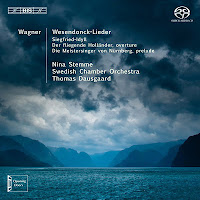The battle was the most dramatic event in Leipzig’s seven
hundred-year history. After two days of fighting, Napoleon moved his troops
into the city. The streets became filled with the dead and wounded with
thousands dying in the plague that followed. One of the victims of the plague
was a police clerk, Friedrich Wagner.
On 22nd May 1813, six months after the death of
Friedrich Wagner, his son was born on the second floor of No. 3 the Bruhl,
known as House of the Red and White Lion,
in Leipzig. He was baptised Wilhelm
Richard Wagner.
Two hundred years
later, as his birth is celebrated, there are numerous releases of recordings,
from complete sets of his operas to single discs such as a new release from BIS
Records www.bis.se .
Thomas Dausgaard http://thomasdausgaard.com and the Swedish Chamber Orchestra http://imgartists.com/artist/swedishchamberorchestra perform the original 1841 version of the
Overture to Der Fliegende Holländer together with the final version from 1860.
These two versions frame Wagner’s Wesendonck-Lieder sung by the Swedish soprano
Nina Stemme http://ninastemme.com , who is particularly known for her
Wagnerian operatic roles and sang the Wesendonck-Lieder at the 2010 Salzburg
International Festival.
Also on this disc is
Wagner’s own transcription for violin and orchestra of the last of the
Wesendonck-Lieder, Träume together with the Siegfried-Idyll and Prelude to Die
Mestersingers von Nürnberg
 |
| BIS 2022 SACD |
This new release is
another in the Open Door series of recordings of romantic symphonic music that
Dausgaard and the Swedish Chamber Orchestra are making for BIS.
The 1841 original version of Wagner’s Overture to ‘Der Fliegende Holländer’ receives a nicely taut performance that has a
directness that brings out much of Wagner’s early thoughts.
After making her debut as Cherubino in Italy, the Swedish
soprano Nina Stemme http://ninastemme.com ,
has appeared at opera houses including Stockholm, Vienna State Opera, Semperoper
Dresden, Geneva, Zürich, Teatro San Carlo Naples, Gran Teatre del Liceu
Barcelona, Metropolitan Opera New York, San Francisco Opera as well as at the
festivals of Bayreuth, Salzburg, Savonlinna, Glyndebourne and Bregenz.
Whilst in no way confined to Wagnerian roles her repertoire
includes Eva (Die Mestersingers von Nürnberg), Elisabeth (Tannhäuser), Elsa (Lohengrin),
Senta (Der Fliegende Holländer), Sieglinde (Die Walküre), and her outstanding
first Isolde (Tristan und Isolde) at Glyndebourne Festival Opera which has now
been issued on DVD. She has also sung Isolde in EMI’s famous recording of Tristan
und Isolde with Placido Domingo and with great success at Bayreuth Festival,
Zurich Opera and Royal Opera House, Covent Garden, London. Further highlights
were her phenomenal Sieglinde and Brünnhilde (Siegfried) in the new Ring cycle
at Vienna State Opera and a sensational Brünnhilde (Die Walküre). She has sung
most recently in Tannhäuser at Opera Bastille Paris, and Brünnhilde (Götterdämmerung)
in the new Ring at Munich State Opera.
Nina Stemme’s Wagner credentials are, therefore, without
doubt.
In the opening Der
Engel (The Angel) of Wesendonck –
Lieder (1857/58) the Swedish Chamber Orchestra provide a lovely opening.
When Nina Stemme enters she is at once powerfully idiomatic, showing her
wonderful ability to extract the exact emotion from the text. With Stehe still (Stand still) she brings a real Wagnerian voice to this
tempestuous song. She has power and fullness to her voice with wonderful
control of dynamics. Stemme excels herself in Im Treibhaus (In the Hothouse) bringing such poetry and sensitivity
to this wonderful song in a lovely performance. She gets terrific support from Thomas
Dausgaard and the Swedish Chamber Orchestra. Schmerzen (Sorrows) gets a terrifically
sweeping opening before Stemme enters in full voice, magnificent, soaring over
the orchestra. There is some fine control of voice in Träume (Dreams), rising to some exquisite moments.
It is fascinating to hear the final, 1860, version of the Overture to ‘Der Fliegende Holländer’ which opens with a grand sweep from the Swedish Chamber
Orchestra under Thomas Dausgaard in a performance and version that shows more
sophistication. There is fine tautness again from this fine chamber orchestra.
Occasionally Dausgaard does seem to hold back a little too much but when he
lets go the effect is terrific.
Siegried - Idyll
(1870) is exquisitely played with just the right amount of free flowing forward
momentum. There are many fine details in this carefully prepared performance
with some lovely woodwind contributions. At times the tempo is quite quick,
adding to the drama and, as the music heads toward the coda there is a
satisfying feel of completion.
With Träume (No.5 of
Wesendonck – Lieder) – version for violin and orchestra (1858) we have an
opportunity to hear Wagner’s own arrangement of this song beautifully played by
Katarina Andreasson. This novelty, nevertheless, reduces this lovely song to
more of an encore or, as Sir Thomas Beecham would have it, a lollipop. Shorn of
the words and vocal texture there is something missing.
Dausgaard doesn’t hang around in the opening of the Prelude to ‘Die Meistersingers von
Nurnberg’ (1862). In this brisk
performance, the smaller sound of the Swedish Chamber Orchestra may lack the
weight of a larger body but what superb clarity there is. This is a really
nicely paced performance.
Overall this is a fine release with an opportunity to hear less
known Wagner as well as a really fine performance of the Wesendonck Lieder.
There is an exceptionally clear and fine recording as well as excellent booklet
notes and full texts in German and English.

No comments:
Post a Comment